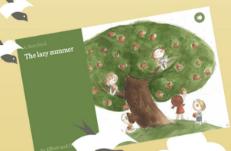
Creative Writing Collaboration

Overview
Creating a story is not an easy task. What should I write about? Who will the characters be in my story? What will happen? These are all questions that every author needs to answer before their story can take shape.
Storybird is an online community that provides original artwork to inspire students. The artwork sparks their imagination and supports story creation. Collaboration can take place when students invite others to work on their stories with them.
Note: This website is no longer free. You can purchase individual subscriptions and/or school and district-wide plans.
Learning Objectives
Students will:
- Be able to use art to inspire a story or poem.
- Be able to create a story or poem.
- Be able to collaborate on their work with another student.
- Be able to communicate effectively with a partner to complete a story or poem.
Vocabulary
Vocabulary Words:
-
Collaborate: When people work together to accomplish a common goal or task, they collaborate.
Pre-planning
To prepare for this lesson:
-
The teacher will need to create a free account on Storybird and create a class.
-
Familiarize yourself with Storybird using their tutorials.
-
Model for students by creating a story together.
-
Work in partnership with another teacher in order to have the students collaborate with students outside of their own classroom.
-
Create a rubric for assessment (see assessment options for details)
Accommodations
See the Accommodations Page and Charts on the 21things4students website in the Teacher Resources.
Steps
Directions for this activity:
-
Students receive their account information and log in to the Storybird website.
-
Next, they choose artwork to begin their story.
-
Students will write the first page of the story by using the artwork as their inspiration.
-
When they are finished, assign them a collaborator by giving them the screen name of another student either in their classroom or the class of the teacher you made arrangements with in the pre-planning.
-
The students will then invite their collaborating partner to continue the story. (See tutorial video in the pre-planning)
Extension: Students can also work to edit and revise the story with their collaborator. The story can continue past the first two pages by having students continue to go back and forth with their collaborator, each writing a page.
Assessment Options
Different options for assessing the students:
- Observations
- Check for understanding
- Create and use a rubric that assesses the students story / poem.
- Some of the rubric points could be:
- Does the story match the chosen artwork?
- Does the story continuation with the collaborative partner make sense?
- Are all story elements present (characters, setting, plot)?
- Does the plot make sense (beginning, middle, end)?
MITECS Competencies & ISTE STANDARDS
MITECS: Michigan adopted the "ISTE Standards for Students" called MITECS (Michigan Integrated Technology Competencies for Students) in 2018.
Global Collaborator
7a. Students use digital tools to connect with learners from a variety of backgrounds and cultures, engaging with them in ways that broaden mutual understanding and learning.
7c. Students contribute constructively to project teams, assuming various roles and responsibilities to work effectively toward a common goal.
Devices and Resources
Device: PC, Chromebook, Mac, iPad
Browser: Chrome, Safari, Firefox, Edge, ALL
App, Extension, or Add-on:
Websites:
Storybird Education
CONTENT AREA RESOURCES
ELA
The students will learn narrative storytelling.
Integrated Arts
Students could use their own artwork to have others create stories about.
Science
Students could choose artwork that represents a science concept they are learning about such as, recycling or rocks. The story they create could be more informational text than narrative.
Social Studies
Students could use the artwork to create a historical fiction story using facts they have learned in social studies.
CREDITS
This task card was created by Jean Smith, Van Buren Schools, May 2018. Updated October 2023.


